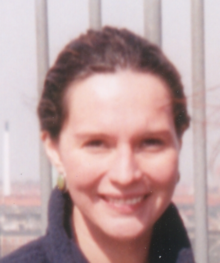Alicia M. Soderberg
Alicia M. Soderberg | |
|---|---|
 A. M. Soderberg on top ofRundetaarnin 2001. | |
| Born | 1977 (age 46–47) Boston |
| Nationality | American |
| Education | PhD,California Institute of Technology |
| Alma mater | California Institute of Technology |
| Awards | Annie Jump Cannon Award in Astronomy |
| Scientific career | |
| Fields | Astrophysics |
| Institutions | Harvard University |
| Thesis | The Many Facets of Cosmic Explosions(2007) |
| Doctoral advisor | Shrinivas Kulkarni |
Alicia Margarita Soderberg(born 1977) is an Americanastrophysicistwhose research focused onsupernovae.She was an assistant professor of astronomy atHarvard Universityand a postdoctoral fellow at theHarvard-Smithsonian Center for Astrophysics.
Early life
[edit]Born inBoston,Soderberg was raised inFalmouth, MassachusettsonCape Cod,and graduated fromFalmouth High School.She also spent summers at the nearbyWoods Hole Oceanographic Institutionstudying the effect of water pollution on coastal ponds.[1]
Education
[edit]Soderberg attendedBates College,where she graduated with aBachelor of Sciencedegree in 2000 with a double major in Math and Physics. During her undergraduate years, she also participated in a number of summer programs, including theCenter for Astrophysics | Harvard & Smithsonian,theCerro Tololo Inter-American ObservatoryinChile,and theLos Alamos National LaboratoryinNew Mexico.She then earned aMaster of Sciencefrom theUniversity of Cambridgein Applied Mathematics. Soderberg was awarded her doctorate in astrophysics from theCalifornia Institute of Technologyunder the guidance of advisorShrinivas Kulkarni,where her thesis used data gathered from thePalomar Observatoryand theVery Large Arrayto provide a better understanding ofgamma ray burstsandstripped core-collapse supernovae.[2]
Career
[edit]On February 18, 2006, Soderberg was a member of a group of researchers who detected thegamma-ray burstGRB 060218located 440 millionlight years(135Mpc) away in the constellationAries.The detection of the associated supernova SN2006aj provided one of the best evidence to date tying gamma-ray bursts and supernovae.[3]
Soderberg and her colleagues detected the supernovaSN 2008Das it was occurring on January 9, 2008, using data fromNASA'sSwift Gamma-Ray Burst MissionX-rayspace telescope,from a precursor star in thespiral galaxyNGC 2770,88 million light years away (27 Mpc). They alerted eight other orbiting and ground-based observatories to record the event.[4][5]The team was able to catch the supernova in action because they had been making observations of NGC 2770 to observe supernovaSN 2007uy.[6]
Awards and honors
[edit]- Annie Jump Cannon Awardin Astronomy (2009)[7]
References
[edit]- ^Bates News (December 14, 1999)."Mashpee student makes stellar discoveries".Bates.Bates College.RetrievedOctober 29,2021.
- ^Short Biography: Alicia Soderberg,Harvard University.Accessed September 7, 2010.
- ^Reddy, Francis."A supernova caught in the act: Astronomers around the world watched as an underpowered gamma-ray burst evolved into an exploding star.",Astronomy Magazine,August 30, 2006. Accessed September 7, 2010.
- ^Overbye, Dennis."Scientists See Supernova in Action",The New York Times,May 22, 2008. Accessed September 7, 2010.
- ^Editorial."In at the Birth of Death",The New York Times,June 2, 2008. Accessed September 7, 2010.
- ^Thompson, Andrea."Supernova Birth Observed for First Time",Space,May 21, 2008. Accessed September 7, 2010.
- ^"Annie Jump Cannon Award in Astronomy | American Astronomical Society".aas.org.RetrievedOctober 8,2018.
- 1977 births
- American women astronomers
- 21st-century American women scientists
- Living people
- Alumni of the University of Cambridge
- Bates College alumni
- California Institute of Technology alumni
- People from Falmouth, Massachusetts
- Discoverers of supernovae
- Recipients of the Annie J. Cannon Award in Astronomy
- Falmouth High School (Massachusetts) alumni
